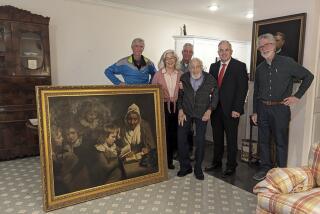Hitch in race for Raphael
- Share via
The J. Paul Getty Museum’s two-year effort to buy a painting by Raphael from a private collection in England received a massive blow Wednesday with the announcement that the British Heritage Lottery Fund will help London’s National Gallery purchase the picture. The fund will contribute about $18.5 million, adding to the approximately $15.3 million already pledged from other sources, gallery officials said.
The painting, “Madonna of the Pinks,” a small devotional image of the Madonna and Christ Child, measuring a mere 11.4 by 9 inches, has been loaned to the National Gallery since 1992 by its owner, the Duke of Northumberland. Last fall, the duke agreed to sell the painting to the Getty, but the gallery launched a campaign to keep the picture in England, and the government placed a temporary ban on its exportation to allow time for fund-raising.
The next step in the contest for the painting is for the British Department of Culture, Media and Sport to determine if the National Gallery’s offer, a total of about $33.8 million, effectively matches the Getty’s bid.
The Getty has not disclosed the price it has agreed to pay for the painting, but British authorities have pegged it at $46.6 million.
Although the National Gallery’s offer is substantially lower than the Getty’s, officials at the British institution say the duke will get a significant tax break if the painting stays in the country, a benefit that would make up the difference in the purchase price.
If British Secretary of State for Culture Tessa Jowell is convinced that the National Gallery has come up with a matching offer, she will refuse to sign an export license for the picture, said Toby Sargent, spokesman for the Department of Culture, Media and Sport. The duke would then be expected to sell the painting to the National Gallery, although British law would not force him to sell it.
Lottery Fund chairwoman Liz Forgan said the agency was not solely impressed by the need to keep a work of art in Britain. “They made their case not only on the basis of the quality of the picture and its importance in the context of the other Raphaels in the collection but also on the basis of a first rate and extremely imaginative education and tourism plan.”
The Getty has not given up on the Raphael, however.
“I remain respectful of the export process and still hopeful,” said Deborah Gribbon, director of the Getty Museum. Determining whether $33.8 million is a viable matching offer is “a very complicated calculation and one that is subject to a great deal of interpretation.” No timetable has been set for the decision, but it is expected to be made before Aug. 27, when the export ban runs out.
“Madonna of the Pinks” portrays the Madonna and her infant son in a scene of joyful intimacy. Raphael, a leading figure of the Italian Renaissance, probably painted the picture in Florence in 1507 or 1508. It is “a painting of immense importance,” Gribbon said. “It would be one of the most important paintings ever to come to the United States. It would be of tremendous benefit to not only our local community but all visitors. And it does seem that it would have a greater impact at a public institution here in Los Angeles than in London where there are already, in a single institution, eight paintings by Raphael.”
If the Getty gets the painting, it would be one of only two Raphaels in California. “Madonna With Child and Book” is at the Norton Simon Museum in Pasadena.
If the Rafael remains in England, however, it would not be the Getty’s first defeat by the British -- or the first time that money from the museum founder’s son, the late John Paul Getty Jr., has worked against the Los Angeles institution.
In 1984 the museum lost a bid to buy a 14th century Siennese painting of the Crucifixion by Duccio. Ten years later, the Getty lost a contest for Italian artist Antonio Canova’s neoclassical sculpture “The Three Graces.” And in 1996, the museum tried but failed to buy 17th century Bolognese artist Guercino’s painting, “Erminia Finding the Wounded Tancred.” In each case, a contribution from the younger Getty. helped the British cause.
About $8 million of the money raised for the Raphael came from an endowment set up by the younger Getty to help the National Gallery buy works of art, a gallery press officer said.
Times staff writers Mike Boehm in Los Angeles and Janet Stobart in London contributed to this report.
More to Read
The biggest entertainment stories
Get our big stories about Hollywood, film, television, music, arts, culture and more right in your inbox as soon as they publish.
You may occasionally receive promotional content from the Los Angeles Times.










